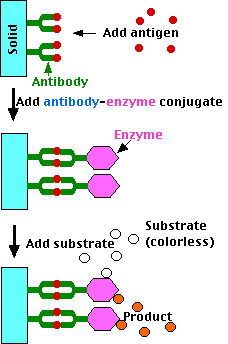Enzyme-Linked Immunosorbent Assay (ELISA)
ELISA is a widely-used method for measuring the concentration of a particular molecule (e.g., a hormone or drug) in a fluid such as serum or urine. It is also known as enzyme immunoassay or EIA.
The molecule is detected by antibodies that have been made against it; that is, for which it is the antigen. Monoclonal antibodies are often used.
 The test requires:
The test requires:
- the antibodies fixed to a solid surface, such as the inner surface of a test tube;
- a preparation of the same antibodies coupled to an enzyme — one (e.g., β-galactosidase) that produces a colored product from a colorless substrate.
Performing the Test
- The tubes are filled with the antigen solution (e.g., urine) to be assayed. Any antigen molecules present bind to the immobilized antibody molecules.
- The antibody-enzyme conjugate is added to the reaction mixture. The antibody part of the conjugate binds to any antigen molecules that were bound previously, creating an antibody-antigen-antibody "sandwich".
- After washing away any unbound conjugate, the substrate solution is added.
- After a set interval, the reaction is stopped (e.g., by adding 1 M NaOH) and the concentration of colored product formed is measured in a spectrophotometer. The intensity of color is proportional to the concentration of bound antigen.
ELISA can also be adapted to measure the concentration of antibodies. In this case,
- The wells are coated with the appropriate antigen.
- The solution (e.g., serum) containing antibodies is added.
- After they have had time to bind to the immobilized antigen,
- an enzyme-conjugated anti-immunoglobulin is added, consisting of
- an antibody against the antibodies being tested for. For example, if human anti-HIV antibodies are being assayed, then antibodies (raised in a goat or rabbit against human immunoglobulins) are conjugated to
- the enzyme.
- After washing away unreacted reagent, the substrate is added.
- The intensity of the color produced is proportional to the amount of enzyme-labeled antibodies bound (and thus to the concentration of the antibodies being assayed).
Literally hundreds of ELISA kits are manufactured for
- research
- human and veterinary diagnosis
Some examples:
- screening donated blood for evidence of viral contamination by
- HIV-1 and HIV-2 (presence of anti-HIV antibodies)
- hepatitis C (presence of antibodies)
- hepatitis B (testing for both antibodies and a viral antigen)
- measuring hormone levels
- HCG (as a test for pregnancy)
- LH (determining the time of ovulation)
- TSH, T3 and T4 (for thyroid function)
- hormones (e.g., anabolic steroids, HGH) that may have been used illicitly by athletes
- detecting infections
- detecting allergens in food and house dust
- measuring "rheumatoid factors" and other autoantibodies in autoimmune diseases like systemic lupus erythematosus
- measuring toxins in contaminated food
- detecting illicit drugs, e.g.,
9 June 2018
 The test requires:
The test requires: